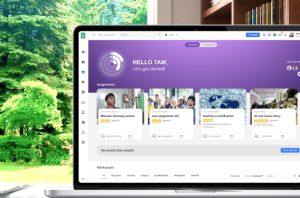A large and leading educational institution in Brazil chose the Blossom platform to manage its distributed learning environment in a much more efficient and cost-effective manner, with the capability of reaching hundreds of thousands of more users.
Advanced, user-friendly platform that grows to fit ongoing learning requirements of a major, multi-campus educational organisation
The Client
A large and leading educational institution in Brazil, with 1,304 learning centres and schools operating in two organisations across 27 states, offering a multitude of programmes and serving millions of students.
The Challenges
The organisation faced several significant challenges affecting its operations and processes:
– The institution offered similar courses in different centers, each with different content. Due to lack of central management, the courses created in one center were not available to the others. Enormous effort and resources were spent in retrieving course content from various systems, each with its own proprietary interface and processes.
– Existing systems lacked support for advanced learning features, such as collaborative learning, project-based learning, support of remote laboratories and simulators and live (online) classes, which is a mandatory requirement for large distributed educational systems.
– Existing systems lacked support for advanced administrative processes such as workflow self-registration, e-commerce, budget, project and workplan management, autonomous portals development and advanced staff administration, which is a solid requirement for large distributed educational systems.
– Lack of integration with other systems, which were required by regulations.
– Lack of a central 360⁰ view and alerts for learning and administrative processes, and the ability to intervene in a timely manner.
– The need for system operations support with state-level independence, utilising advanced hardware and communication infrastructure that the customer had already invested heavily in.
– The institution was not reaching its full potential due to an inability to provide learning programmes to users in remote areas and lack of qualified teachers.
The client sought a comprehensive solution to support content creation and publishing; integrate advanced learning aids (such as project-based learning and live classes); administrate educational processes; permit all parties, including secretaries, teachers, students and content creators to work on the same platform; and yet allow for independent operation and system hosting at the regional level.
The Solution
After a long and thorough bidding process, the client chose the Blossom platform to manage its distributed learning environment in a much more efficient and cost-effective manner, with the capability of reaching hundreds of thousands of more users.
Promoting uniformity of content, courses and schools’ independence:
While adhering to corporate policies and being hosted on different server farms, each school can now monetise itself, using its own portal, logo, and repository of content. The school’s independence is mediated by corporate administrators who centrally monitor the creation, sharing and maintenance of content.
Encouraging teachers to combine online and social learning in their teaching methods:
Using Blossom’s advanced interactive learning and content features, the students can now interact and collaborate with peers and teachers online. Via the platform’s project, research and learning tools, teaching staff can boost the level of user engagement and acquire more students from remote locations who were previously unable to participate in learning programs.
Overcoming the elephant in the room – Migration and integration from and with dozens of systems
Most of the 27 states had one or two systems already in use, and some used other information systems which could not be disposed of, due to regulatory reasons, and therefore needed to be integrated into the new platform. With Blossom’s smart migration tools and dynamic API, the client could easily integrate with other systems and migrate all the needed data, so that users could continue to work without being affected by the change.








